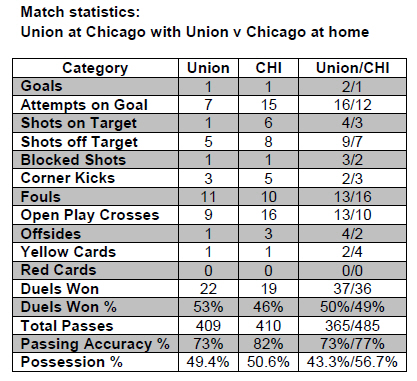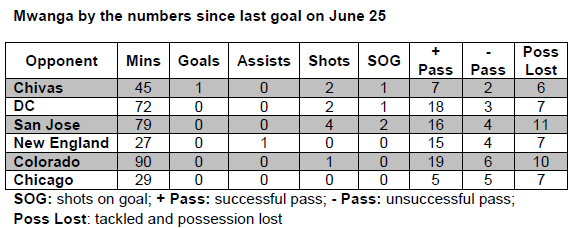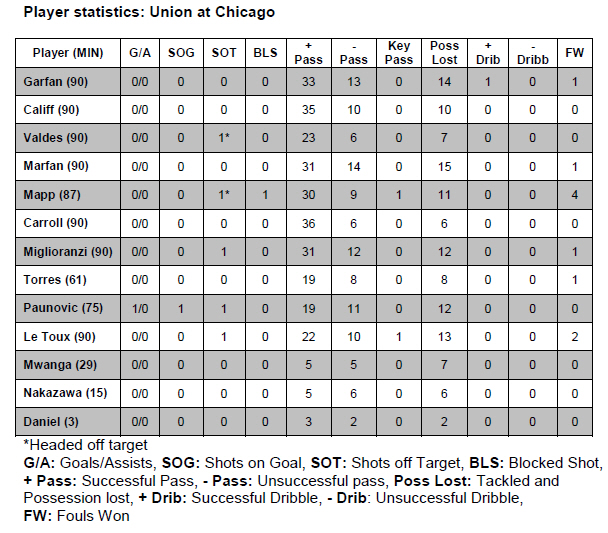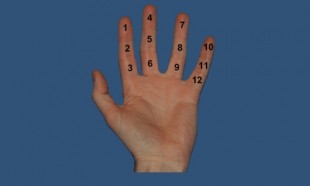In Chicago on Wednesday night, it was another ugly showing by the Union.
In 90 minutes of play, the Union managed one shot on goal. Fortunately, Veljko Paunovic made no mistake with the shot. Recording three shots on goal in six appearances, he has now scored two goals.
With a little time away from the emotions of the match, it is perhaps easier to accept that a point on the road is a good thing (even if three points are what should be expected when the Union plays one of its games in hand against a last place team). It also remains true that, as was discussed last week, the Union are unbeaten in 2011 when they score first. Their record when doing so now stands at 7–0–3, with a road record of 3–0–1. And, importantly, for the fifth time this season the Union prevented the beginning of a losing streak, doing so for the first time on the road.
Match statistics
 In two previous matches, first against Dallas and then against Vancouver, the Union recorded only one shot. Both of those matches were also on the road and both ended as losses with the Union goalless. The only time they have made no shots on goal was in the 1–0 loss in LA.
In two previous matches, first against Dallas and then against Vancouver, the Union recorded only one shot. Both of those matches were also on the road and both ended as losses with the Union goalless. The only time they have made no shots on goal was in the 1–0 loss in LA.
During the PSP’s live commentary of the Chicago match, several comments were made about turnovers. The 73 percent passing accuracy recorded by the Union against Chicago is by no means their worst. As discussed last week, after twenty games the Union averaged 73.2 percent passing accuracy at home and 72 percent on the road for a combined average of 72.6 percent. Their passing accuracy in Chicago was thus right in line with the season average.
What may have made the Union turnovers so apparent was that Chicago recorded a passing accuracy average of 82 percent, nine percent better than the Union.
The worse passing accuracy numbers recorded by the Union so far in 2011 are 63 percent in the scoreless draw against San Jose away (San Jose was 6 percent better with 69 percent ), 64 percent in the 1–1 draw with Colorado away (Colorado was nine percent better with 73 percent), and 69 percent in the 0–2 loss to Dallas (which actually bested the 62 percent recorded by Dallas by seven percent).
Over the course of this season, the greatest passing accuracy deficit recorded by the Union was actually in the win against New York where the Union’s 74 percent completion rate was 11 percent less than New York’s 85 percent. The greatest passing accuracy percentage recorded by the Union was against New England. In that 3–0 win, the Union’s 78 percent passing accuracy was nine percent better than New England’s 69 percent.
Shot on goal percentage
 Returning to the Union’s only shot on goal, I thought it might be interesting to see if there is any relation between shots on goal and shots compared with goals and match outcome. We can get a shots on goal percentage by dividing the number of shots on goal by the number of shots taken.
Returning to the Union’s only shot on goal, I thought it might be interesting to see if there is any relation between shots on goal and shots compared with goals and match outcome. We can get a shots on goal percentage by dividing the number of shots on goal by the number of shots taken.
Looking at the numbers over the course of the season, the shots on goal percentage ranges from a low of zero percent in the 0–1 loss on the road to LA to a high of 63 percent in the 1–0 win at home against San Jose, a win that actually came from a penalty kick goal.
In losses, the Union has never done better than 25 percent of shots being shots on goal. The lowest percentage for draws is the 14 percent just recorded against Chicago. Before that game, the lowest percentage of shots on goal to shots was 22 percent in the away draw against Colorado. Among the Unions eight draws, the highest percentage was 50 percent at home against Real Salt Lake.
Of the Union’s eight wins, the lowest percentage of shots on goal was the 25 percent recorded, interestingly enough, in the 2–1 win against Chicago at home. The highest percentage, again, came in the home win against San Jose.
As described last week, the Union averaged 4.4 shots on goal at home compared to 3.5 on the road over the first twenty games. In terms of the shots on goal percentage, at home the Union average 37 percent while on the road they average 25 percent.
Looking for a correlation between shots on goal percentage and goals scored, the numbers are kind of all over the place. So far, when the Union have scored three or more goals their shots on goal percentage has ranged from 31 percent to 53 percent. When scoring two or more goals, the shots on goal percentage is 25 percent or better. The shots on goal percentage when scoring one goal ranges from 14 percent to 57 percent. When scoring no goals, the percentage ranges from zero percent to 33 percent.
What has happened to Danny?
The Le Toux slump has been on going for longer than any of us wants to remember. Looking at the numbers, it is becoming increasingly obvious that Danny Mwanga is in a bit of a slump of his own.

Since scoring the game winner against Chivas on June 25 as a sub, Mwanga has scored no goals although he assisted Sheanon William’s stoppage time goal in the 3–0 win against New England on July 17.
In the five games since the Chivas game, Mwanga’s best outing may have been in the scoreless draw against San Jose in which he recorded four shots and two shots on goal. In the three games after that, Mwanga has recorded only one shot and no shots on goal.
Chicago was not a very good outing for Mwanga. Aside from showing a dispiriting hesitancy to pull the trigger with no shots or shots on goal recorded, Mwanga’s passing accuracy also sharply declined. As a sub against Chivas, Mwanga’s passing accuracy was 78 percent. Getting the start against DC, his accuracy was 86 percent. As a starter against San Jose, he was 80 percent accurate. As a sub against New England, Mwanga’s passing accuracy was at 79 percent. Starting against Colorado, Mwanga’s passes were 76 percent accurate. These are all very impressive numbers. Against Chicago, however, Mwanga averaged just 50 percent passing accuracy.
Overall, Chicago simply was not a good game for anyone, with the exception of Faryd Mondragon and perhaps Danny Califf and Carlos Valdes. While most of the players had their moments, the simply wonderful Paunovic goal being a prime example of that, consistency will not be a word used in connection with the Union’s performance in that game except for indicating its absence. While the return of Sheanon Williams should help re-solidify the defense, it is the midfield and front line that are once again in doubt. One thing is for sure, it’ll take more than moments of good play for the Union to get confidently back on track.



Comments